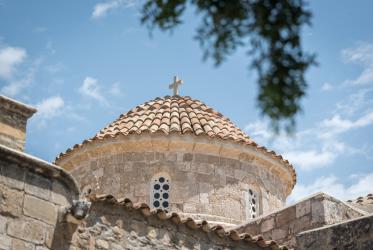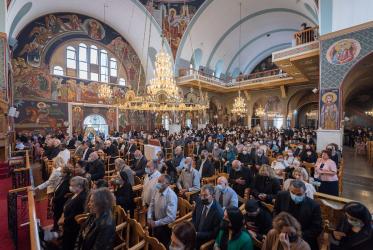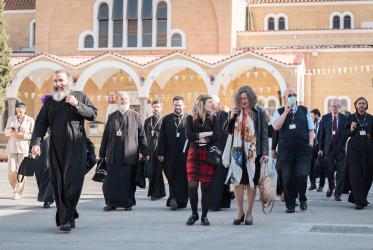by Metropolitan Gennadios of Sassima
in Report of sub-committee II
Special Commission on Orthodox participation in the WCC
(Vilemov, Czech Republic, August, 2000)
The ecumenical movement, the place of togetherness of Christian Churches, and not only this, is marked since its beginning with an ecclesial understanding and an action of worshipping and style of life which was developed throughout all of its history. Thus, Worship became the essential part of life of the ecumenical movement, bringing people from various Church traditions together in prayer and in one communion-koinonia of fellowship in the love of Christ. Worship is also considered the sacred and holy heart of every Christian Church and community, because Christian liberty and virtue arise out of the fertile soil of the Church's memory "anamnesis " of the central salvific events in the life, death and resurrection of our Lord Jesus Christ and the fulfillment of the Kingdom of God.
Nevertheless, a pervasive influence of secularism in Western culture has constricted the Christian imagination and invention of new things and forms. The experience of the eschatological "future" is being lost and the morally formative and spiritually transformative power of the liturgy is diminishing. On the other hand the Orthodox tradition holds that the remembrance (or anamnesis) of the Kingdom in eucharistic worship remains the substantial soil from which grows all that belongs singularly to Christian ethics and style of life in Christ.
Were the liturgy of the eucharist merely one source of authority among others for Christian ethics, this impoverishment of the experience of worship would not pose a problem quite as severe, nor would this crisis of Christian ethics and life in Christ be so acute.
But the liturgy is not just one among a variety of authorities and sources for Christian ethics: it is its ontological condition. It is the principal of a dialogical encounter where God and human beings meet and the ecclesial body, the community or the synaxis is knit together to form a single cloth of narrative, teaching repentance and forgiveness, confession and proclamation, prophesy and doxology. This cloth is woven on the extensive frame of an eschatological vision. As the vision of the Kingdom of God recedes from the consciousness of Christians the cloth unravels, the threads pull apart, and some Christians hang onto one thread or another; some identify the Church primarily in its teaching function, others in its prophetic or proclamatory mode, others as a moral community dedicated in service to the poor or powerless.
This loss of eschatological vision has the added effect blurring the boundaries of Church and world. Christians themselves have become often unsure about what makes their ethics distinctive. This distinctiveness effects the whole life of the ecumenical movement and the inner life of the World Council of Churches' participation for the search for the Church unity in particular.
Since the Enlightenment advanced Processes of secularization within the Church of Christ itself have opened the doors for the entrance of secular ethics, whether Kantian, Hegelian or Marxist. The deterioration of Christian worship and disciplines of prayers has deprived the Churches of necessary tools of discernment and creativity to build ethics from within the ecclesial body itself. Ordinary Christians very often adopt secular moralities without knowing the difference between these moralities and Christian style of life, ethos and ethics.
The Christian world is in "Schism", and there is little unity, and lit-tle agreement, among those who "believe in Jesus' name", who confess Christ Jesus as God and Savior, who put their trust in him and proclaim, by word and deed, their ultimate allegiance to Him as their Lord. There are, in fact, numerous Christian bodies which claim the name of the Church for themselves - and they are out of communion - koinonia with one another, sometimes in open and bitter antagonism.
Today, the unity of faith has fallen apart in many cases. The, unity of love has cooled. The body of Christians has been utterly disrupted. Only the hope of unity has not been fully lost, and perhaps this is the only token of unity still left in divided Christendom.
The Orthodox participating in the ecumenical movement have always struggled by making an appeal and addressing an invitation to their ecumenical partners that: Christians have to begin to know the truth, the "aletheia" of the Good News, to believe and to love the Ecclesia, the Church of Christ, to embrace it even in difficult circumstances and painful mo-ments of its history, to suffer, witness and confess it, to defend it even if martyrdom be the cost. Thus is the Christian way of worshipping, by communication directly and with open hearts to face the Lord and his Church. The analogical koinonia is the real participation in the Kingdom of God, not yet fulfilled, but already present among us.
We need to find ways in which the worship services in which the liturgical convergence can become clear to everyone, so that people are aware that it is the liturgy of the Church they using not a Methodist service or a Roman mass nor an eucharistic liturgy of the Orthodox. As such awareness grows, will not this question arise: "If we have the same worship service, why are we separate?" Another factor was the rapid growth in an individualistic, consumer-oriented approach to the Church and the resulting audience-style worship.
The convergence in worship does not have uniformity as its goal. Nor is it meant to signal a massive retreat to the 3rd or 4th century. What the ecumenical movement says about unity and diversity applies equally to worship. In 1978, meeting in Bangalore, the Faith and Order Commission affirmed:
"Many say that true unity requires the gathering of all in each place into one eucharistic community; there would be no room for a con-tinuing life of the confessional traditions. Others say that unity ac-cording to Christ's will does not necessary require the disappearance but rather the transformation of confessional identities to such degree that unity in full sacramental fellowship, common witness and servi-ce, together with some common structural institutional expression becomes possible. While the first view is rather connected with the concept of 'organic unity', those proposing the concept 'unity in reconciled diversity` hold the second. The two concepts are not seen as alternatives. They may be two different ways of reaching to the ecumenical necessities and possibilities of different situations and of different church traditions".1
Today, in the ecumenical field the choice is not between style and ethos or institution and task, but rather between different aspects of the -one task, which is to be in one communion of faith and Conciliar fellow-ship. In the many critical situations we have faced in the ecumenical movement, the question has constantly been: to what extent must we give priority to the task of maintaining the fellowship between the Churches and to keep alive the main issue in priority which is the unity of the Church; and to what extent is the other responsibility bearing a clear witness against the injustice of the world?
For its life in unity, the Church requires regular gatherings, con-sultations, common decisions and the testing of these decisions by a process of reception. The earliest example of such representative ga-thering may be found in the synaxis of the Apostles in Acts Chap. 15. The Church was freed with the possibility of a serious spit. The issue at stake was of far reaching consequences and could easily have divided the Church for centuries. The response to the danger was quite spontaneous. The leaders had to meet and consider the issue in an assembly. Of course, this first assembly was of a rather unique nature.
Subsequently, "Conciliarity" found expression in various forms: local synods, in regular regional synods of bishops, in assemblies and councils, of the Christian Roman Empire, etc. Perhaps among these various forms a basic distinction needs to be drawn between regular gatherings required for governing the Church and gatherings which were called for special reasons.
Councils either Ecumenical or local do not sometimes serve the unity of the Church. They can also be a source of division, - as history shows - as any instrument towards unity can be misused and become di-visive. There are two extremes which need to be avoided. Councils can disregard the participation of the Church. They can try to impose their guidance on the Church. They will then provoke resistance and possible rifts which cannot easily be healed. They can also be overcautious and refrain from offering guidance at all. Such abdication will equally create confusion and division. Councils serve their purpose if the guidance re-sults from the participatory process, and if at the same time the Council is firm and determined enough to initiate a participatory process.
The practice of conciliar life continued in the separate traditions until today. Each Church developed its own mode of representative gathering. The Eastern Churches, due to their peculiar historical tradition, experiencing the conciliarity the synodical system in an institutional form and action. They rely on the unaltered and also uninterpreted teaching of the Ancient Councils. The Western Churches created new forms of conciliar assemblies: the papal councils which developed out of the Roman episcopal synod under the influence of the increasing dominance of the idea of primacy; the reform and union councils of the late Middle Ages; the synods as ecclesial representative on the basis of the Reformation understanding of Scripture and Community. In the twentieth century almost all Churches have experienced a revival of conciliar life. Under the pressure of the many new and unexpected challenges of a changed world, they have acutely felt the need of consultation and gui-dance.
The question then arose quite naturally: can the different practices of conciliar life not converge and become one? Some voices in the ecumenical movement raised years ago the question: Can the ecumeni-cal movement not be understood as the anticipation of a future common practice of conciliar life, as the place where each church purifies its own approach and prepares itself for that future conciliar event which, one day, may bring together the representatives of all churches and which will proclaim the gospel in new appropriate ways?
What then is conciliar fellowship? The answer can be very sim-ple. It is communion-koinonia among the Churches which are suffi-ciently closely knit to be capable of celebrating such "a genuinely universal council". No council can be held without this communion in its full sense.
The Nairobi statement underlines that all local churches need to form one fellowship across local, national, ethnic and linguistic boundaries. They share in the same faith and need to recognize each other as churches belonging to Christ. The term "conciliar fellowship" presup-poses not a static but a dynamic understanding of unity. The Church is a living human-divine organism which requires from all its members constant attention and care in order to remain faithful in faith and in eucharistic communion. The goal of conciliar fellowship lies still in the future.
Concluding these thoughts and reflections a question is raised. There is still an ethos and style within the life of World Council of Churches, or we are still in the search of such a form of existing to-gether?
After a century of the ecumenical movement existence, and more of fifty years of presence of WCC, it would be said that the ethos which is emerged from the Churches' Participation in the fellowship of toge-therness is an ethos in ambiguity, unclear undetermined which needs to be clarified by the Churches themselves. This unclearness presupposes that the Churches have to re-appropriate their tasks and goals towards the koinonia-communion in an eucharistic fellowship, of the same Body and Blood of Christ, where at the same time still remain divided.
Notes:
- Quoted from G. Gassmann, ed. Documentary History of Faith and Order 1963-1993; Faith and Order Paper No. 159, Geneva WCC Publications 1993, p. 78.




